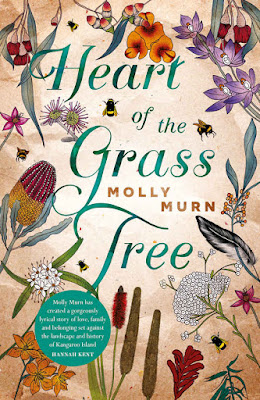Heart of the Grass Tree
Molly Murn’s Heart of the Grass Tree (2018) is a complex
story and one that reveals her courage and ambition. In writing this, I know
that certain readers will remember Sir Humphrey Appleby’s particular use of the
word ‘courageous’ in Yes Minister to
suggest something brave but politically risky. Murn’s novel
is courageous in the more profound sense that she takes the reader into the ‘heart
of the grass tree’ – and that heart means confronting historical injustices for
the indigenous Ngarrindjeri people.
Murn obviously cares deeply about her subject matter; her approach
demonstrates sensitivity, balancing scholarship with seeking
permission from individual Ngarrindjeri people. This she outlines in the ‘Author’s
Note’. The sensitivity is evident also
in her narrative structure. By including a contemporary story – a young
woman grieving for her recently departed grandmother – the reader is introduced
into the universal idea of ‘story’ and ‘place’ through the special memories
Pearl has for Kangaroo Island and her grandmother – a woman of obvious strength,
surprising Pearl even after her death.
Heart of the Grass Tree moves between a number of viewpoints, and between the past and the present. Nor is the past just one time and place:
there is the story centred around William (1822), a sealer’s son who begins to
know Ngarrindjeri ways and language through a young woman, Maringani. Nell’s
story is another layer, slowly revealed – a story told in her own words which
explains something of her toughness and which connects Pearl (as her
granddaughter) to the deeper sense of place and hidden stories of the indigenous
people. Then there is Pearl, her mother Diana, Pearl’s partner Nico, her sister
Lucy, and the whole, sticky mess of complex loves, jealousies and resentments
that make up a multigenerational family with skeletons in the closet.
The structure is complex and readers will need to be active
in their approach to follow every strand. This said, Murn’s language is contemporary
and her characterisation is empathetic. Dialogue is set out in the modern style without quotation
marks so that we can move easily between interior and exterior viewpoints. Distinct sections within chapters assist transitions between viewpoints. I admire the novel not only for its courage, but also its success in
mixing the dense and light, the poetic and dramatic, stories that are familiar with those requiring permission to tell. Fittingly the novel ends with a
passage about grief and reconciliation: ‘Release it from the heart place where
it grew – Nell’s love, her own grief, and all the ways we are connected to each
other’ (280). Heart of the Grass Tree is about connection to place, to country, and ultimately, to each other.




Comments
Post a Comment